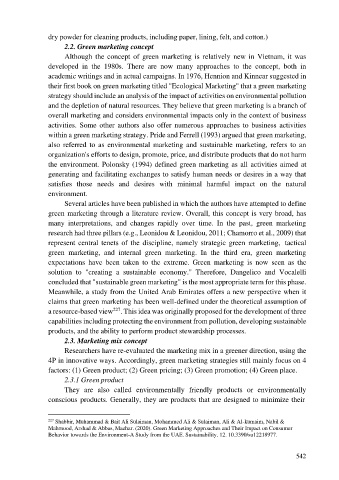Page 550 - Ebook HTKH 2024
P. 550
dry powder for cleaning products, including paper, lining, felt, and cotton.)
2.2. Green marketing concept
Although the concept of green marketing is relatively new in Vietnam, it was
developed in the 1980s. There are now many approaches to the concept, both in
academic writings and in actual campaigns. In 1976, Hennion and Kinnear suggested in
their first book on green marketing titled "Ecological Marketing" that a green marketing
strategy should include an analysis of the impact of activities on environmental pollution
and the depletion of natural resources. They believe that green marketing is a branch of
overall marketing and considers environmental impacts only in the context of business
activities. Some other authors also offer numerous approaches to business activities
within a green marketing strategy. Pride and Ferrell (1993) argued that green marketing,
also referred to as environmental marketing and sustainable marketing, refers to an
organization's efforts to design, promote, price, and distribute products that do not harm
the environment. Polonsky (1994) defined green marketing as all activities aimed at
generating and facilitating exchanges to satisfy human needs or desires in a way that
satisfies those needs and desires with minimal harmful impact on the natural
environment.
Several articles have been published in which the authors have attempted to define
green marketing through a literature review. Overall, this concept is very broad, has
many interpretations, and changes rapidly over time. In the past, green marketing
research had three pillars (e.g., Leonidou & Leonidou, 2011; Chamorro et al., 2009) that
represent central tenets of the discipline, namely strategic green marketing, tactical
green marketing, and internal green marketing. In the third era, green marketing
expectations have been taken to the extreme. Green marketing is now seen as the
solution to "creating a sustainable economy." Therefore, Dangelico and Vocalelli
concluded that "sustainable green marketing" is the most appropriate term for this phase.
Meanwhile, a study from the United Arab Emirates offers a new perspective when it
claims that green marketing has been well-defined under the theoretical assumption of
227
a resource-based view . This idea was originally proposed for the development of three
capabilities including protecting the environment from pollution, developing sustainable
products, and the ability to perform product stewardship processes.
2.3. Marketing mix concept
Researchers have re-evaluated the marketing mix in a greener direction, using the
4P in innovative ways. Accordingly, green marketing strategies still mainly focus on 4
factors: (1) Green product; (2) Green pricing; (3) Green promotion; (4) Green place.
2.3.1 Green product
They are also called environmentally friendly products or environmentally
conscious products. Generally, they are products that are designed to minimize their
227 Shabbir, Muhammad & Bait Ali Sulaiman, Mohammed Ali & Sulaiman, Ali & Al-kumaim, Nabil &
Mahmood, Arshad & Abbas, Mazhar. (2020). Green Marketing Approaches and Their Impact on Consumer
Behavior towards the Environment-A Study from the UAE. Sustainability. 12. 10.3390/su12218977.
542

